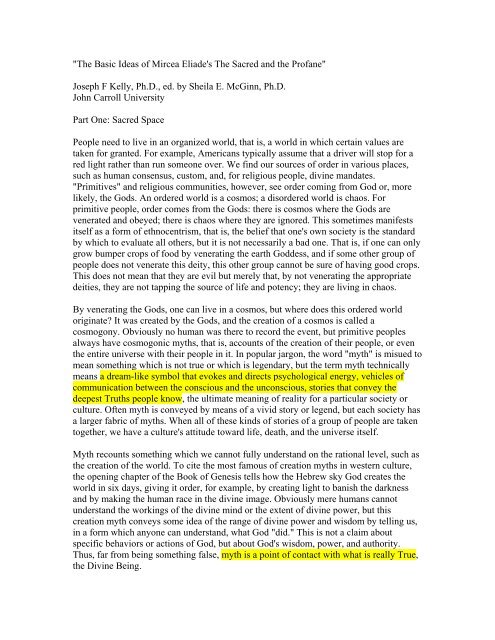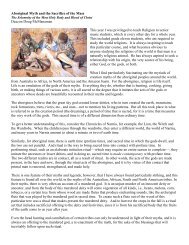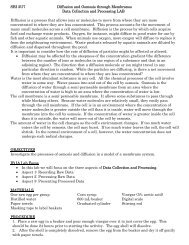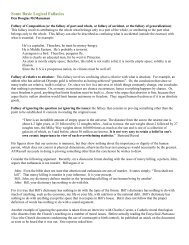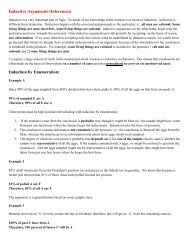"The Basic Ideas of Mircea Eliade's The Sacred and the Profane"
"The Basic Ideas of Mircea Eliade's The Sacred and the Profane"
"The Basic Ideas of Mircea Eliade's The Sacred and the Profane"
You also want an ePaper? Increase the reach of your titles
YUMPU automatically turns print PDFs into web optimized ePapers that Google loves.
"<strong>The</strong> <strong>Basic</strong> <strong>Ideas</strong> <strong>of</strong> <strong>Mircea</strong> <strong>Eliade's</strong> <strong>The</strong> <strong>Sacred</strong> <strong>and</strong> <strong>the</strong> Pr<strong>of</strong>ane"<br />
Joseph F Kelly, Ph.D., ed. by Sheila E. McGinn, Ph.D.<br />
John Carroll University<br />
Part One: <strong>Sacred</strong> Space<br />
People need to live in an organized world, that is, a world in which certain values are<br />
taken for granted. For example, Americans typically assume that a driver will stop for a<br />
red light ra<strong>the</strong>r than run someone over. We find our sources <strong>of</strong> order in various places,<br />
such as human consensus, custom, <strong>and</strong>, for religious people, divine m<strong>and</strong>ates.<br />
"Primitives" <strong>and</strong> religious communities, however, see order coming from God or, more<br />
likely, <strong>the</strong> Gods. An ordered world is a cosmos; a disordered world is chaos. For<br />
primitive people, order comes from <strong>the</strong> Gods: <strong>the</strong>re is cosmos where <strong>the</strong> Gods are<br />
venerated <strong>and</strong> obeyed; <strong>the</strong>re is chaos where <strong>the</strong>y are ignored. This sometimes manifests<br />
itself as a form <strong>of</strong> ethnocentrism, that is, <strong>the</strong> belief that one's own society is <strong>the</strong> st<strong>and</strong>ard<br />
by which to evaluate all o<strong>the</strong>rs, but it is not necessarily a bad one. That is, if one can only<br />
grow bumper crops <strong>of</strong> food by venerating <strong>the</strong> earth Goddess, <strong>and</strong> if some o<strong>the</strong>r group <strong>of</strong><br />
people does not venerate this deity, this o<strong>the</strong>r group cannot be sure <strong>of</strong> having good crops.<br />
This does not mean that <strong>the</strong>y are evil but merely that, by not venerating <strong>the</strong> appropriate<br />
deities, <strong>the</strong>y are not tapping <strong>the</strong> source <strong>of</strong> life <strong>and</strong> potency; <strong>the</strong>y are living in chaos.<br />
By venerating <strong>the</strong> Gods, one can live in a cosmos, but where does this ordered world<br />
originate? It was created by <strong>the</strong> Gods, <strong>and</strong> <strong>the</strong> creation <strong>of</strong> a cosmos is called a<br />
cosmogony. Obviously no human was <strong>the</strong>re to record <strong>the</strong> event, but primitive peoples<br />
always have cosmogonic myths, that is, accounts <strong>of</strong> <strong>the</strong> creation <strong>of</strong> <strong>the</strong>ir people, or even<br />
<strong>the</strong> entire universe with <strong>the</strong>ir people in it. In popular jargon, <strong>the</strong> word "myth" is misued to<br />
mean something which is not true or which is legendary, but <strong>the</strong> term myth technically<br />
means a dream-like symbol that evokes <strong>and</strong> directs psychological energy, vehicles <strong>of</strong><br />
communication between <strong>the</strong> conscious <strong>and</strong> <strong>the</strong> unconscious, stories that convey <strong>the</strong><br />
deepest Truths people know, <strong>the</strong> ultimate meaning <strong>of</strong> reality for a particular society or<br />
culture. Often myth is conveyed by means <strong>of</strong> a vivid story or legend, but each society has<br />
a larger fabric <strong>of</strong> myths. When all <strong>of</strong> <strong>the</strong>se kinds <strong>of</strong> stories <strong>of</strong> a group <strong>of</strong> people are taken<br />
toge<strong>the</strong>r, we have a culture's attitude toward life, death, <strong>and</strong> <strong>the</strong> universe itself.<br />
Myth recounts something which we cannot fully underst<strong>and</strong> on <strong>the</strong> rational level, such as<br />
<strong>the</strong> creation <strong>of</strong> <strong>the</strong> world. To cite <strong>the</strong> most famous <strong>of</strong> creation myths in western culture,<br />
<strong>the</strong> opening chapter <strong>of</strong> <strong>the</strong> Book <strong>of</strong> Genesis tells how <strong>the</strong> Hebrew sky God creates <strong>the</strong><br />
world in six days, giving it order, for example, by creating light to banish <strong>the</strong> darkness<br />
<strong>and</strong> by making <strong>the</strong> human race in <strong>the</strong> divine image. Obviously mere humans cannot<br />
underst<strong>and</strong> <strong>the</strong> workings <strong>of</strong> <strong>the</strong> divine mind or <strong>the</strong> extent <strong>of</strong> divine power, but this<br />
creation myth conveys some idea <strong>of</strong> <strong>the</strong> range <strong>of</strong> divine power <strong>and</strong> wisdom by telling us,<br />
in a form which anyone can underst<strong>and</strong>, what God "did." This is not a claim about<br />
specific behaviors or actions <strong>of</strong> God, but about God's wisdom, power, <strong>and</strong> authority.<br />
Thus, far from being something false, myth is a point <strong>of</strong> contact with what is really True,<br />
<strong>the</strong> Divine Being.
People worship <strong>the</strong> Gods because <strong>the</strong>y affect us, usually in a positive way. If <strong>the</strong> Gods<br />
existed but had no contact with us, no one would care about <strong>the</strong>m: why pray for a good<br />
harvest to a God who had nothing to do with <strong>the</strong> earth? Religion exists because <strong>the</strong> Gods<br />
do act in our world. Eliade suggests that <strong>the</strong> Gods do not just do things but <strong>the</strong>y show us<br />
what to do <strong>and</strong>, <strong>of</strong>ten, how to do <strong>the</strong>m. <strong>The</strong> Gods establish a paradigm, an open-ended<br />
model, for people to follow. For example, when <strong>the</strong> Gods created <strong>the</strong> world, <strong>the</strong>y<br />
established a cosmos; every time humans plant crops or build a house <strong>the</strong>y are, in some<br />
way, repeating <strong>the</strong> cosmogony because <strong>the</strong>y are bringing order to a space. Where <strong>the</strong>re<br />
was scrub l<strong>and</strong> <strong>the</strong>re is now a field <strong>of</strong> corn; where <strong>the</strong>re was an empty space <strong>the</strong>re is now<br />
a house <strong>of</strong> people who venerate <strong>the</strong> Gods. When <strong>the</strong>y follow <strong>the</strong> paradigm, <strong>the</strong>y are<br />
creating sacred space, that is, a place which reflects <strong>the</strong> ordered cosmos <strong>of</strong> <strong>the</strong> Gods; this<br />
is distinct from pr<strong>of</strong>ane space, that is, space in which <strong>the</strong> Gods are unknown or not<br />
venerated. Often people use a ritual to highlight <strong>the</strong> fact that <strong>the</strong>y are repeating <strong>the</strong><br />
cosmogony <strong>and</strong> that <strong>the</strong>y are marking <strong>of</strong>f sacred space.<br />
How it might this apply in our culture? Take an example. <strong>The</strong> average JCU student taking<br />
RL 101 is eighteen or nineteen years old. If you have a room in a dormitory or apartment,<br />
you started <strong>the</strong> school year with a vacant space. If you have a room at home, think <strong>of</strong><br />
when you first moved into that room <strong>and</strong> <strong>the</strong> space was empty. What did you do with it?<br />
You created a space which reflects your own values. You chose certain furniture to use<br />
but rejected o<strong>the</strong>rs; you arranged <strong>the</strong> furniture in a particular way; you chose certain<br />
items to decorate <strong>the</strong> room but rejected o<strong>the</strong>rs. If you have a gr<strong>and</strong>parent living with you<br />
at home, <strong>the</strong> average visitor to your home would probably have little trouble<br />
distinguishing your room from your gr<strong>and</strong>parent's. Your room will reflect your values;<br />
you have created it in your image <strong>and</strong> likeness. In <strong>the</strong> same way, groups <strong>of</strong> people<br />
(nations, tribes, religious communities) create a cosmos to reflect <strong>the</strong> values <strong>the</strong>y hold<br />
important. For "primitives" <strong>and</strong> religious communities, <strong>the</strong>se are <strong>the</strong> values <strong>the</strong>y received<br />
from <strong>the</strong> Gods.<br />
As noted above, a cosmogony is a paradigm. Since it is open-ended, it can be extended<br />
indefinitely. For example, for pious Jews, Israel is <strong>the</strong> Holy L<strong>and</strong>, within which is<br />
Jerusalem, <strong>the</strong> Holy City, <strong>and</strong> within Jerusalem is <strong>the</strong> Wailing Wall, clearly a more holy<br />
location than <strong>the</strong> secular parts <strong>of</strong> <strong>the</strong> city. All <strong>the</strong>se are sacred places but <strong>of</strong> different<br />
intensities.<br />
<strong>The</strong> essence <strong>of</strong> a sacred place is that it puts one in contact with <strong>the</strong> Gods. <strong>Sacred</strong> places<br />
are sacred because <strong>the</strong>y were consecrated (made sacred) by a "hierophany," that is, <strong>the</strong><br />
manifestation <strong>of</strong> a higher being. (<strong>The</strong> manifestation <strong>of</strong> a God is a <strong>the</strong>ophany; all<br />
<strong>the</strong>ophanies are hierophanies but not <strong>the</strong> reverse, for example, <strong>the</strong> apparition <strong>of</strong> an angel<br />
would be a hierophany but not a <strong>the</strong>ophany.) <strong>The</strong> place where <strong>the</strong> hierophany occurs<br />
becomes a sacred place.<br />
Sometimes <strong>the</strong> hierophany is unexpected. For example, <strong>the</strong> Bible says that <strong>the</strong> Israelite<br />
patriarch Jacob once dreamt <strong>of</strong> a ladder going up to heaven; when he awoke, he declared<br />
that place where he slept to be a sacred place because a hierophany occurred <strong>the</strong>re. He
called <strong>the</strong> place Beth-el, that is, "House <strong>of</strong> God" (Genesis 28:10-22). One finds many<br />
examples <strong>of</strong> <strong>the</strong>se kinds <strong>of</strong> hierophanies in which people had visions or auditions <strong>of</strong> Gods<br />
in or near (what became) sacred forests, sacred trees, sacred lakes, sacred mountains, <strong>and</strong><br />
<strong>the</strong> like.<br />
Sometimes <strong>the</strong> hierophany is invited. For example, if goodly numbers <strong>of</strong> Roman<br />
Catholics move into a certain area, <strong>the</strong> local diocese will establish a parish in that area<br />
<strong>and</strong> <strong>the</strong>n build <strong>and</strong> consecrate a church <strong>the</strong>re--that is, <strong>the</strong>y will do prayers <strong>and</strong> blessings,<br />
celebrate Mass, <strong>and</strong> <strong>the</strong>reby invoke a <strong>the</strong>ophany. During this first Mass, <strong>the</strong>y consecrate a<br />
Tabernacle to hold <strong>the</strong> reserved Eucharist where <strong>the</strong>y believe that Christ is present in a<br />
special way. Thus when Roman Catholics enter <strong>the</strong> church, <strong>the</strong>y consider <strong>the</strong>mselves in<br />
<strong>the</strong> presence <strong>of</strong> God in a way that is not true outside <strong>the</strong> church building.<br />
People who are in a sacred place will exhibit different behavior than <strong>the</strong>y do in o<strong>the</strong>r<br />
(pr<strong>of</strong>ane) places. For example, a Roman Catholic might shout out a greeting to a friend in<br />
<strong>the</strong> parking lot, but <strong>the</strong>y would not do so in <strong>the</strong> middle <strong>of</strong> <strong>the</strong> church itself.<br />
In <strong>the</strong> Genesis 28 story, Jacob also called <strong>the</strong> place where he slept <strong>the</strong> "gate <strong>of</strong> heaven,"<br />
because in that place he came in contact with <strong>the</strong> world <strong>of</strong> <strong>the</strong> divine. This illustrates a<br />
key feature <strong>of</strong> sacred space: a sacred place is a threshold, that is, a point where one can<br />
cross over from <strong>the</strong> common (pr<strong>of</strong>ane) world <strong>of</strong> everyday life to a sacred world. This<br />
sounds ra<strong>the</strong>r unusual, but we experience a similar kind <strong>of</strong> thing every day. For example,<br />
<strong>the</strong> doorway to a classroom is a threshold; in <strong>the</strong> hall you can act more freely than you<br />
can inside <strong>the</strong> classroom. Or again, when you cross <strong>the</strong> threshold <strong>of</strong> your own room, you<br />
enter a space with where different values apply than in <strong>the</strong> classroom or <strong>the</strong> living room<br />
<strong>of</strong> your home. Religious examples <strong>of</strong> this are <strong>the</strong> threshholds <strong>of</strong> churches, synagogues, or<br />
temples. Individual families sometimes reflect <strong>the</strong> religious nature <strong>of</strong> <strong>the</strong>ir homes by<br />
putting a mezzuzah or cross or even a small holy water font on one <strong>of</strong> <strong>the</strong> door posts.<br />
<strong>The</strong>se signs remind those who enter that this house (<strong>and</strong> family) is dedicated to God;<br />
thus, inside this house certain values are maintained no matter what may go on outside.<br />
Part Two: <strong>Sacred</strong> Time<br />
<strong>The</strong> creation <strong>of</strong> <strong>the</strong> world is <strong>the</strong> great cosmogonic paradigm, <strong>the</strong> most important thing <strong>the</strong><br />
Gods ever did <strong>and</strong> <strong>the</strong> model for all which we should do. This cosmogony, although a<br />
spatial creation, also took place at a certain "time." Hence, we find <strong>the</strong> notion <strong>of</strong> sacred<br />
time. <strong>The</strong> term for sacred time is chairos, while <strong>the</strong> term for "normal" (pr<strong>of</strong>ane,<br />
quotidian) time is chronos.<br />
When <strong>the</strong> Gods created space, <strong>the</strong>y also created time. First <strong>of</strong> all, time could not begin<br />
until those things which measure it came into existence; likewise when space disappears,<br />
it will be <strong>the</strong> end <strong>of</strong> time. This at first seems strange to us because we have separated time<br />
from space; we consult watches or calendars, not <strong>the</strong> sun or <strong>the</strong> moon, to gauge time. But<br />
if we think about it, we realize how closely <strong>the</strong> two are related. For example, a year is not<br />
365 days; in fact, a year is almost six hours longer which is why <strong>the</strong>re is need for an extra<br />
day every four years (leap year). A year is actually <strong>the</strong> time it takes <strong>the</strong> earth to orbit <strong>the</strong>
sun. If, by some chance, that time were shortened by one week to 358 days <strong>and</strong> we did<br />
not alter <strong>the</strong> calendar, within a dozen years <strong>the</strong> first day <strong>of</strong> spring would fall on what is<br />
now <strong>the</strong> first day <strong>of</strong> winter.<br />
When you measure time by space, you see how much goes in cycles. Every day <strong>the</strong> sun<br />
rises, climbs into <strong>the</strong> sky, hits its peak, descends, sets, disappears, <strong>and</strong> <strong>the</strong>n rises <strong>the</strong> next<br />
day. Every month <strong>the</strong> moon waxes <strong>and</strong> wanes; every year <strong>the</strong> earth goes through <strong>the</strong><br />
cycle <strong>of</strong> <strong>the</strong> seasons. This led some traditional societies to speak <strong>of</strong> time itself as cyclical<br />
(e.g., Hindu culture). Eastern cultures in general are inclined toward this view <strong>of</strong> time.<br />
Because <strong>of</strong> <strong>the</strong> Biblical tradition, Western cultures view time as linear, that is, when<br />
something happens, it has happened once <strong>and</strong> for all. Similar things might happen again,<br />
but <strong>the</strong>y are not identical. <strong>The</strong>y may be coincidences or be caused by similar<br />
circumstances.<br />
Eliade suggested that traditional societies see <strong>the</strong> forces <strong>of</strong> <strong>the</strong> earth recurring on a regular<br />
basis without change. Obviously, <strong>the</strong>re might be individual changes as rivers changed<br />
<strong>the</strong>ir courses or plants grew where seeds had been planted, but <strong>the</strong> overall cycle <strong>of</strong> life<br />
was unchanging.<br />
This leads to a central point in <strong>Eliade's</strong> <strong>the</strong>ory. <strong>The</strong> great event, as we noted above, is <strong>the</strong><br />
cosmogony, when <strong>the</strong> Gods created <strong>the</strong> world. For societies which share this cyclical<br />
view <strong>of</strong> time (where <strong>the</strong> world moves through cycles), <strong>the</strong> cosmogony was repeated<br />
annually. We have already seen that a cosmogony means a creation <strong>of</strong> a cosmos, an<br />
ordered world. In <strong>the</strong> cycle <strong>of</strong> <strong>the</strong> seasons, winter represents chaos, <strong>the</strong> time when <strong>the</strong><br />
earth is dying (although in this case chaos is a preparation for cosmos). In <strong>the</strong> spring, <strong>the</strong><br />
world comes back to life, cosmos has returned. In traditional societies, New Year's rites<br />
usually take place in <strong>the</strong> spring because that is when <strong>the</strong> year actually begins. (Our own<br />
calendar reflects this slightly. <strong>The</strong> word September means <strong>the</strong> seventh month because in<br />
<strong>the</strong> old Roman calendar <strong>the</strong> first month was March.)<br />
Eliade fur<strong>the</strong>r suggested that this belief in <strong>the</strong> annual repetition <strong>of</strong> <strong>the</strong> cosmogony<br />
resulted in several now-familiar religious customs. For example, as <strong>the</strong> time for <strong>the</strong><br />
festival approached, <strong>the</strong> entire world went into decline <strong>and</strong> returned to chaos. This meant<br />
that, at <strong>the</strong> New Year, <strong>the</strong> entire world <strong>and</strong> <strong>the</strong> people in it were born again. <strong>The</strong> basic<br />
idea behind this is that people are part <strong>of</strong> <strong>the</strong> natural world <strong>and</strong> are caught up in <strong>the</strong><br />
movement <strong>of</strong> nature; if <strong>the</strong> world is renewed, so are we. <strong>The</strong> cleansing <strong>of</strong> <strong>the</strong> "old leaven"<br />
before Passover for Jews, <strong>and</strong> <strong>the</strong> kindling <strong>of</strong> <strong>the</strong> "new fire" at <strong>the</strong> Christian Easter Vigil<br />
are two example <strong>of</strong> religious traditions based on this idea.<br />
This idea that time can begin again <strong>and</strong> we, as part <strong>of</strong> nature, are caught up in this return<br />
to <strong>the</strong> cosmogony may sound like a cosmic time machine, but that is not really what this<br />
means. We find ideas like this in everyday language <strong>and</strong> customs. For example, if you<br />
become run down <strong>and</strong> constantly fatigued (probably from reading too much about<br />
Eliade), a physician may tell you to get some recreation. Look at what <strong>the</strong> word means:<br />
re-creation, that is, to be created again. Similar words are renew, to become new again,
<strong>and</strong> rejuvenation, literally, to become young again. <strong>The</strong> governing idea is that by doing<br />
certain things, such as exercising, we can return ourselves to that time when we were<br />
younger, healthier, <strong>and</strong> <strong>the</strong> like.<br />
Consider also <strong>the</strong> notion <strong>of</strong> New Year's resolutions. If <strong>the</strong>re is something about yourself<br />
which must be corrected, why wait until January 1st to do something about it? Why not<br />
resolve now to study more, watch television less, etc.? Yet <strong>the</strong> tradition <strong>of</strong> making<br />
resolutions as one begins a new year still is meaningful for people. <strong>The</strong>re must be some<br />
way that a new time somehow affects us, so we think we will be different because <strong>the</strong><br />
time is different. This may be merely self-deception if we don't actually do something<br />
different with <strong>the</strong> new time -- <strong>the</strong> way someone who has not studied since kindergarten<br />
says confidently, "Next semester I'll do better." -- but it may actually lead to real changes<br />
if we seize <strong>the</strong> opportunity. Planning how to "put <strong>the</strong> right foot forward" at <strong>the</strong> beginning<br />
<strong>of</strong> a new semester, or a new job, or when moving into a new social group is a similar kind<br />
<strong>of</strong> thing. Each "new" time opens up possibilities that really were not available before, in<br />
<strong>the</strong> "old" time <strong>and</strong> old situation. And starting <strong>of</strong>f "on <strong>the</strong> wrong foot" makes it much<br />
harder to establish good relationships. E.g., it may take a month <strong>of</strong> being on time before<br />
someone forgets that you were late for <strong>the</strong> first date.<br />
From <strong>the</strong>se examples you can see that, like sacred space, <strong>the</strong> notion <strong>of</strong> sacred time is also<br />
paradigmatic <strong>and</strong> can be extended. For example, <strong>the</strong> repetition <strong>of</strong> <strong>the</strong> cosmogony may be<br />
<strong>the</strong> great sacred day, but <strong>the</strong>re are many individual sacred days, such as Christmas or<br />
Passover in which time is qualitatively different from pr<strong>of</strong>ane time for those, such as<br />
Christians <strong>and</strong> Jews, who belong to those religious traditions.<br />
<strong>The</strong> prevailing notion for Eliade is that <strong>the</strong> time <strong>of</strong> creation was a good one, that all <strong>the</strong><br />
divine forces were at work on <strong>the</strong> earth (as, for example, in <strong>the</strong> Genesis 2 story <strong>of</strong> <strong>the</strong><br />
Garden <strong>of</strong> Eden where Adam <strong>and</strong> Eve lived in harmony with God <strong>and</strong> nature before <strong>the</strong>y<br />
ate <strong>the</strong> forbidden fruit). This may sound like nothing more than nostalgia, <strong>the</strong> belief that<br />
somehow everything was so much better at an earlier time in history, like <strong>the</strong> way older<br />
people might idealize <strong>the</strong> time <strong>of</strong> <strong>the</strong>ir youth. But <strong>the</strong> examples above show that this<br />
notion <strong>of</strong> a "time <strong>of</strong> creation" is not merely that. In fact, in some ways <strong>the</strong> idea <strong>of</strong> "sacred<br />
time" takes its meaning as much from <strong>the</strong> open-endedness <strong>of</strong> <strong>the</strong> future as it does from<br />
<strong>the</strong> treasured experiences <strong>of</strong> <strong>the</strong> past. This is a key example <strong>of</strong> how a "religious"<br />
phenomenon is religious precisely because it highlights a common human phenomenon.<br />
<strong>The</strong>re are two important consequences to this <strong>the</strong>ory <strong>of</strong> sacred time. First, <strong>the</strong> cosmogony<br />
is actually repeated during foundational religious rituals. <strong>The</strong>se are not simply acts <strong>of</strong><br />
"memory" in <strong>the</strong> sense <strong>of</strong> thinking about something that happened in <strong>the</strong> past. A preacher<br />
might urge a congregation to "picture yourselves listening to Jesus telling a parable," but<br />
that is basically an intellectual exercise where people try to imagine what those events<br />
might have been like. "<strong>Sacred</strong> time," however, is <strong>the</strong> ritualized experience where<br />
participants actually do go "back in time" or, more accurately, bring that "past" sacred<br />
time "forward" into <strong>the</strong> present reality <strong>of</strong> <strong>the</strong> celebrating community. Obviously, if<br />
participants were to "step outside" <strong>the</strong> ritual event, <strong>the</strong>y could see that <strong>the</strong>y did not<br />
physically change <strong>the</strong> place where <strong>the</strong>y were <strong>and</strong> that time actually continued to pass
during <strong>the</strong> ritual. But, as long as <strong>the</strong> participants actively are involved in <strong>the</strong> ritual event,<br />
<strong>the</strong> power <strong>of</strong> <strong>the</strong> ritual mysteriously unites all "times" into one sacred time, one chairos.<br />
If <strong>the</strong> ritual is a cosmogonic one, participants are united with <strong>the</strong> divine forces <strong>of</strong> creation<br />
so that, as <strong>the</strong> Gods are creating <strong>the</strong> world, <strong>the</strong> human participants are contemporaneous<br />
with <strong>the</strong> Gods -- <strong>and</strong> those cosmogonic events are actually taking place in <strong>the</strong>ir presence.<br />
This is a difficult notion for us, because if something is actually occurring, we cannot<br />
predict its outcome; for example, if some past Super Bowl were actually being re-played,<br />
could we be sure <strong>the</strong> final score would be <strong>the</strong> same or even that <strong>the</strong> same team would<br />
win? During a ritual enactment <strong>of</strong> <strong>the</strong> creation, however, <strong>the</strong>re really is no chance that<br />
"this time" <strong>the</strong> primeval dragon will defeat <strong>the</strong> Sky-God. <strong>The</strong>re are two reasons for this.<br />
FIrst <strong>of</strong> all, clearly <strong>the</strong> ritual has been rehearsed <strong>and</strong> will be acted out reliably. Secondly,<br />
<strong>and</strong> more importantly, it is because <strong>the</strong> ritual is not "re"presenting a past event but, in<br />
fact, is celebrating that one creative act as a present event. <strong>Eliade's</strong> point is that <strong>the</strong> people<br />
are ritually part <strong>of</strong> <strong>the</strong> original action because <strong>the</strong>y have been carried along, with all <strong>of</strong><br />
Nature, into <strong>the</strong> creative act <strong>of</strong> <strong>the</strong> cosmogony. However, <strong>the</strong> only way <strong>the</strong> cosmogony<br />
can be ritually enacted is if <strong>the</strong> people know what happened, <strong>and</strong> this is where <strong>the</strong> myth<br />
plays its great role.<br />
As noted earlier, myth is not a fairy tale or a legend, but ra<strong>the</strong>r a narrative which puts<br />
humans in contact with <strong>the</strong> deepest values <strong>of</strong> a culture <strong>and</strong> <strong>the</strong> source <strong>of</strong> those values. For<br />
religious cultures, this means that myth puts humans in contact with <strong>the</strong> Divine Reality<br />
itself.<br />
<strong>The</strong> cosmogonic myth is <strong>the</strong> paradigmatic model <strong>of</strong> <strong>the</strong> creation. It tells people what <strong>the</strong><br />
Gods did <strong>and</strong> thus enables people to become one with <strong>the</strong> Gods in <strong>the</strong> repetition <strong>of</strong> <strong>the</strong><br />
cosmogony. Although <strong>the</strong> mythic stories are well-known in a given culture, <strong>the</strong> myths are<br />
usually told on some sacred occasion. <strong>The</strong> New Year's rite is perhaps <strong>the</strong> most obvious,<br />
but Eliade has many examples <strong>of</strong> lesser occasions. Among some Pacific tribes engaged in<br />
fishing, <strong>the</strong>re is a myth recounting how <strong>the</strong> God <strong>of</strong> <strong>the</strong> people made <strong>the</strong> first net, <strong>and</strong> so<br />
before <strong>the</strong> people go fishing, this myth is recounted for <strong>the</strong>m <strong>and</strong> <strong>the</strong>y make <strong>the</strong>ir nets as<br />
God first made his. This is also true for weapons used by hunting peoples <strong>and</strong> for<br />
agricultural tools used by farming peoples. To this day in Massachusetts, <strong>the</strong> Roman<br />
Catholic Archbishop <strong>of</strong> Boston blesses <strong>the</strong> fishing fleet in New Bedford before it sets out;<br />
many <strong>of</strong> <strong>the</strong> fishermen are Catholics <strong>of</strong> Portugese descent. <strong>The</strong>refore, when we study<br />
myths, we are actually studying powerful expressions <strong>of</strong> a society's beliefs <strong>and</strong> an<br />
important means <strong>of</strong> conveying truth.<br />
[N.B. Eliade basically took an anthropological approach, examining how myth functions<br />
in primitive societies; <strong>the</strong> great psychologist Carl Gustav Jung also examined myth from<br />
a psychological point <strong>of</strong> view <strong>and</strong> likewise found it to be a great vehicle for conveying<br />
truth. Clearly Jung's approach deserves a separate treatment.]<br />
Ano<strong>the</strong>r essential point in <strong>Eliade's</strong> underst<strong>and</strong>ing <strong>of</strong> religious thought is that <strong>the</strong> Gods<br />
manifested <strong>the</strong>ir presence not just in great acts, such as Yahweh's apparition to Moses in<br />
<strong>the</strong> burning bush, but in <strong>the</strong> very physical structure <strong>of</strong> world. This is NOT animism (that
is, <strong>the</strong> worship <strong>of</strong> natural phenomena). Ra<strong>the</strong>r, it is <strong>the</strong> belief that various elements in <strong>the</strong><br />
natural world are hierophanies, that is, <strong>the</strong>se elements manifest <strong>the</strong> Gods' presence <strong>and</strong><br />
power.<br />
<strong>The</strong> primal hierophany is <strong>the</strong> sky. It is omnipresent; you can go to places where <strong>the</strong>re is<br />
no l<strong>and</strong> or no water, no trees or no animals but everywhere on earth <strong>the</strong>re is <strong>the</strong> sky. <strong>The</strong><br />
sky is not only vast but unreachable; no matter how high you climb, you still cannot<br />
reach it. Fur<strong>the</strong>rmore, it is powerful. Too much sun, plants wi<strong>the</strong>r; not enough sun, <strong>the</strong>y<br />
grow poorly. Not enough rain, <strong>the</strong> earth dries out; too much rain, <strong>the</strong>re are floods. <strong>The</strong><br />
sky <strong>and</strong> its gifts are essential for life, <strong>the</strong> primal gift <strong>of</strong> <strong>the</strong> Gods. For religions which see<br />
<strong>the</strong> Gods as essentially very different from human beings, <strong>the</strong> sky's insubstantiality is<br />
ano<strong>the</strong>r factor. <strong>The</strong> earth, like us, is <strong>of</strong> solid substance; <strong>the</strong> sky, which is above, has no<br />
"earthly" substance.<br />
<strong>The</strong> consequences <strong>of</strong> this are obvious -- in almost every religion <strong>the</strong> Gods live in <strong>the</strong> sky.<br />
If not all do, <strong>the</strong> sky Gods usually are <strong>the</strong> supreme ones who literally lord it above <strong>the</strong><br />
o<strong>the</strong>rs. In most societies, <strong>the</strong> sky God is portrayed as male, reflecting <strong>the</strong> social patriarchy<br />
(that is, a society ruled by men) on <strong>the</strong> human level. [A society ruled by women is a<br />
matriarchy.] Often <strong>the</strong> sky God does not intervene directly in human affairs. He is simply<br />
too powerful <strong>and</strong>, thus, leaves that to Gods with lesser but more specific powers.<br />
This tendency to see <strong>the</strong> upper regions as <strong>the</strong> home <strong>of</strong> <strong>the</strong> Gods is reflected in much<br />
human behavior. For example, if a company owns an <strong>of</strong>fice tower, <strong>the</strong> higher you climb<br />
<strong>the</strong> company ladder, <strong>the</strong> more likely you are to get an <strong>of</strong>fice physically higher up --<br />
indeed, even <strong>the</strong> symbolism <strong>of</strong> "climbing <strong>the</strong> ladder" reflects this notion that those with<br />
more power <strong>and</strong> authority are "higher."<br />
Opposite <strong>the</strong> sky is <strong>the</strong> earth, which <strong>of</strong>ten pictured as female because it has children<br />
(humans, animals) which it nourishes (with plants); Mo<strong>the</strong>r Earth is one <strong>of</strong> <strong>the</strong> most<br />
common notions in religious life. This notion is <strong>of</strong>ten ambivalent, since <strong>the</strong> earth also<br />
receives <strong>the</strong> dead, but, in many societies, this return to Mo<strong>the</strong>r Earth is a prelude to rebirth.<br />
Many primitive religions have a hierogamy, literally, a higher marriage, when Fa<strong>the</strong>r Sky<br />
marries Mo<strong>the</strong>r Earth, fertilizing her with <strong>the</strong> rain. This, not surprisingly, is <strong>the</strong> paradigm<br />
for all human marriages, <strong>and</strong> Eliade actually found an Indian marriage formula in which<br />
<strong>the</strong> man says that he is <strong>the</strong> sky <strong>and</strong> his wife is <strong>the</strong> earth. Most fertility rites in ancient<br />
societies somehow involved veneration <strong>of</strong> <strong>the</strong> Earth.<br />
This concept survives in our language. <strong>The</strong> Latin word for "mo<strong>the</strong>r" is mater, from which<br />
we get <strong>the</strong> English words "matter" <strong>and</strong> "material," that is, solid substances, things from<br />
<strong>the</strong> earth, in contrast to <strong>the</strong> vaporous substance <strong>of</strong> <strong>the</strong> sky.<br />
We cannot live without <strong>the</strong> sky or <strong>the</strong> earth, but nei<strong>the</strong>r can we live without water, <strong>and</strong>,<br />
for Eliade, water is <strong>the</strong> third great hierophany. Water is even more ambivalent than <strong>the</strong><br />
earth. <strong>The</strong> earth is solid <strong>and</strong> has shape; water, on <strong>the</strong> o<strong>the</strong>r h<strong>and</strong>, is in itself shapeless <strong>and</strong>
thus an easy symbol <strong>of</strong> chaos. But since we cannot live without water, its chaos is a<br />
prelude to cosmos, <strong>and</strong> <strong>the</strong>re are numerous myths in which <strong>the</strong> hero or an entire people<br />
cross water to reach a promised l<strong>and</strong>, such as <strong>the</strong> Israelites passing through <strong>the</strong> Red Sea.<br />
<strong>Basic</strong>ally, when people enter water, <strong>the</strong>y return to chaos <strong>and</strong> thus <strong>the</strong>ir current forms<br />
(e.g., slaves in Egypt) dissolve into chaos, but when <strong>the</strong>y emerge from <strong>the</strong> water, <strong>the</strong>y<br />
come out as part <strong>of</strong> a cosmos (a free people). In ancient Christianity, baptism was <strong>of</strong>ten<br />
by immersion, that is, one went completely under water, signifying a destruction <strong>of</strong> <strong>the</strong><br />
old (pagan) forms, presaging a rebirth into a cosmic form as a Christian. Anyone, <strong>of</strong><br />
course, could see that <strong>the</strong> waters from Fa<strong>the</strong>r Sky impregnate Mo<strong>the</strong>r Earth. <strong>The</strong> notion<br />
<strong>of</strong> a fountain <strong>of</strong> youth, waters which restore lost youth <strong>and</strong> potency, is a good example <strong>of</strong><br />
an aquatic hierophany.<br />
Associated with this are <strong>the</strong> many rites <strong>of</strong> cleansing used in religion.<br />
<strong>The</strong>se are <strong>the</strong> great, universal hierophanies, but <strong>the</strong>re are many lesser but still important<br />
hierophanies. For example, <strong>the</strong> most important gift <strong>the</strong> Gods can give is life, <strong>and</strong> few<br />
things show life more than plants. Even today, when we know a lot about <strong>the</strong> science <strong>of</strong><br />
botany, we can still be amazed how tiny seeds produce full-grown plants. Any plant can<br />
be a hierophany, but, since we have seen that myths convey truths about <strong>the</strong> Gods, it is<br />
common in myth to find some kind <strong>of</strong> sacred plant, such as <strong>the</strong> plant <strong>of</strong> youth in<br />
<strong>the</strong>Mesopotamian Epic <strong>of</strong> Gilgamesh or <strong>the</strong> tree <strong>of</strong> life <strong>and</strong> <strong>the</strong> tree <strong>of</strong> <strong>the</strong> knowledge <strong>of</strong><br />
good <strong>and</strong> evil in <strong>the</strong> biblical Garden <strong>of</strong> Paradise. <strong>The</strong> moon is a hierophany <strong>of</strong> fertility.<br />
Not only does its waxing <strong>and</strong> waning show a constant pattern <strong>of</strong> birth, growth, decline,<br />
death, <strong>and</strong> rebirth, <strong>the</strong> moon also goes through a monthly cycle as does a woman's<br />
menstrual cycle, <strong>and</strong> menstruation is a sign that a girl has now become physically a<br />
woman, that is, that she can bear children, an important event in <strong>the</strong> life <strong>of</strong> a primitive<br />
tribe where births were not taken for granted.<br />
Finally, stones can also be hierophanies -- not so much pebbles but ra<strong>the</strong>r sizeable masses<br />
<strong>of</strong> rock, for example, sacred mountains or pyramids or even something like Stonehenge.<br />
Stones have solidity <strong>and</strong> power <strong>and</strong> <strong>the</strong>y do not change. To be sure, geologists tell us that<br />
a mountain range will eventually be eroded to <strong>the</strong> ground, but, in <strong>the</strong> light <strong>of</strong> human life<br />
span, it is unchangeable. Since <strong>the</strong> Gods are usually free from <strong>the</strong> changes <strong>and</strong><br />
vicissitudes <strong>of</strong> human life, stones seem like a good hierophany for <strong>the</strong>m, as <strong>the</strong> popularity<br />
<strong>of</strong> sacred stones in primitive religions proves.<br />
<strong>Eliade's</strong> final point that since traditional cultures underst<strong>and</strong> <strong>the</strong> natural world to contain<br />
hierophanies, <strong>the</strong>y try to live <strong>the</strong>ir lives in harmony with this world. <strong>The</strong>y can see a<br />
sacred dimension in many daily acts, such as cooking, eating, hunting, sexual activity,<br />
farming, <strong>and</strong> <strong>the</strong> like. This does not mean that <strong>the</strong>se activities are any less dem<strong>and</strong>ing or<br />
pleasing for <strong>the</strong>m than <strong>the</strong>y are for us, but ra<strong>the</strong>r that primitive peoples realize that <strong>the</strong>se<br />
acts are more than just human acts; for example, farming provides food for life as <strong>the</strong><br />
farmer works with Fa<strong>the</strong>r Sky <strong>and</strong> Mo<strong>the</strong>r Earth to produce <strong>the</strong> plants which give us life.<br />
People may even build <strong>the</strong>ir homes to reflect <strong>the</strong> natural world; for example, <strong>the</strong>re are<br />
societies which have huts with holes in <strong>the</strong> ro<strong>of</strong>, symbolizing <strong>the</strong> small opening at <strong>the</strong> top
<strong>of</strong> <strong>the</strong> human skull (which does not close completely at birth), <strong>and</strong> <strong>the</strong> soul <strong>of</strong> a deceased<br />
person can escape through <strong>the</strong> two holes <strong>and</strong> into <strong>the</strong> sky to be with <strong>the</strong> Gods. Many<br />
structures, especially formally religious ones, are built with doors open to <strong>the</strong> four<br />
directions to symbolize <strong>the</strong> wholeness <strong>of</strong> <strong>the</strong> religion, or with <strong>the</strong>ir focus <strong>of</strong> worship<br />
facing east toward <strong>the</strong> rising sun, or on top <strong>of</strong> a high place because this puts <strong>the</strong> house <strong>of</strong><br />
worship closer to <strong>the</strong> primal hierophany.<br />
Some societies even see <strong>the</strong> body as reminiscent <strong>of</strong> <strong>the</strong> cosmos with <strong>the</strong> two eyes<br />
corresponding to <strong>the</strong> two lights <strong>of</strong> <strong>the</strong> sky.<br />
Because nature has separate elements performing separate functions, such as water or<br />
earth, many primitive peoples separate men <strong>and</strong> women or adults <strong>and</strong> children into<br />
groups with specific functions to perform. In a modern society which does usually not<br />
limit social functions or jobs on <strong>the</strong> basis <strong>of</strong> gender or age, this would be discriminatory,<br />
but, for primitives, this is following <strong>the</strong> natural pattern.<br />
Some primitive rites which initiate people into <strong>the</strong>se societies seem harsh by our<br />
st<strong>and</strong>ards, but, in <strong>the</strong>ir context, make some sense. Eliade tells <strong>of</strong> one primitive group<br />
which separates girls who have <strong>the</strong>ir first menstruation from <strong>the</strong> rest <strong>of</strong> society by<br />
shutting <strong>the</strong>m up in a darkened hut until <strong>the</strong> menstruation is over a few days later. This<br />
seems psychologically cruel, but <strong>the</strong> intent is symbolize for <strong>the</strong> girl her return to <strong>the</strong><br />
womb (<strong>the</strong> darkened hut) as a reminder that her own womb is now fertile <strong>and</strong> to<br />
emphasize that she is dying as a girl to be born again as a woman.<br />
Here again <strong>the</strong> modern parallels are not difficult to see. Our society has many rites <strong>of</strong><br />
passage; for example, if you did not go through <strong>the</strong> rite <strong>of</strong> high school graduation, you<br />
would not be in college. <strong>The</strong> rite is tw<strong>of</strong>old - it marks <strong>the</strong> end <strong>of</strong> your life as a high school<br />
student <strong>and</strong> <strong>the</strong> beginning <strong>of</strong> your life as a high school graduate, that is, you are dying to<br />
one type <strong>of</strong> life to be born again into ano<strong>the</strong>r.<br />
Modern religions have many rites <strong>of</strong> passage; to use Christianity as an example, <strong>the</strong>re are<br />
rites <strong>of</strong> baptism, confirmation (for some denominations), marriage, <strong>and</strong> funerals. In each<br />
case, <strong>the</strong> Christian "dies" to one form <strong>of</strong> life to be born into ano<strong>the</strong>r.<br />
<strong>Eliade's</strong> description <strong>of</strong> life deals heavily with <strong>the</strong> role which religion plays in society. He<br />
believes that, as a culture moves fur<strong>the</strong>r <strong>and</strong> fur<strong>the</strong>r from <strong>the</strong> traditional world-view, <strong>the</strong><br />
smaller <strong>and</strong> smaller role <strong>the</strong>se religious ideas will play in our lives. What do you think?


